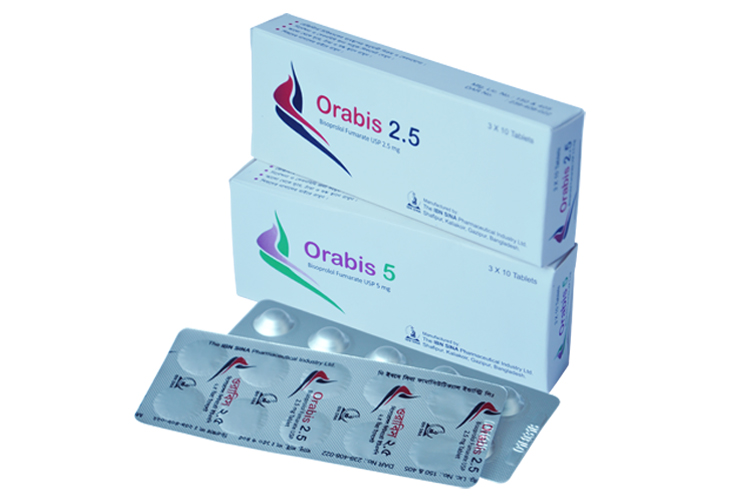
ORABIS
BISOPROLOL HEMIFUMARATE USP
| NAME | STRENGTH | PACK SIZE | DOSAGE FORM |
|---|---|---|---|
| ORABIS 5 MG | 5 MG | 30 S | TABLET |
| ORABIS 2.5 MG | 2.5 MG | 30 S | TABLET |
Orabis 2.5 Tablet : Each film coated tablet contains Bisoprolol Fumarate USP 2.5 mg .
Orabis 5 Tablet : Each film coated tablet contains Bisoprolol Fumarate USP 5 mg.
Bisoprolol is a beta1-selective (cardioselective) adrenoceptor blocking agent without significant membrane stabilizing activity or intrinsic sympathomimetic activity in its therapeutic dosage range.
Orabis is indicated in the treatment of hypertension, angina and heart failure. It may be used alone or in combination with other antihypertensive agents.
The usual starting dose is 5 mg once daily. In some patients, 2.5 mg may be an appropriate starting dose. If the antihypertensive effect of 5 mg is inadequate, the dose may be increased to 10 mg and then, if necessary, to 20 mg once daily.
For heart failure: Initially 1.25 mg once daily (in the morning) for 1 week then, if well tolerated, increased to 2.5 mg once daily for 1 week, then 3.75 mg once daily for 1 week, then 5 mg once daily for 4 weeks, then 7.5 mg once daily for 4 weeks, then 10 mg once daily; max. 10 mg daily.
Bisoprolol is contraindicated in patients with cardiogenic shock, overt cardiac failure, second or third degree AV block and marked sinus bradycardia.
Impaired Renal or Hepatic Function.
Diarrhoea, dizziness, drowsiness, fatigue, headache, lightheadedness, nausea, sleeplessness, unusual tiredness, weakness, Severe allergic reactions (rash, hives, itching, difficulty breathing, tightness in the chest, swelling of the mouth, face, lips, or tongue), chest pain, difficulty breathing, lightheadedness or dizziness when rising from a lying or sitting position, very slow heartbeat.
Pregnancy Category C. There are no adequate and well-controlled studies in pregnant women. Bisoprolol should be used during pregnancy only if the potential benefit justifies the potential risk to the fetus.
Nursing Mothers: Small amounts of bisoprolol fumarate (< 2% of the dose) have been detected in the milk of lactating rats. It is not known whether this drug is excreted in human milk.
Because many drugs are excreted in human milk caution should be exercised when bisoprolol fumarate is administered to nursing women.
Other ß-blocking Agents: Bisoprolol fumarate should not be combined with other ß-blocking agents.
Catecholamine-Depleting Drugs: Patients receiving catecholamine-depleting drugs, such as reserpine or guanethidine, should be monitored closely because the added ß-adrenergic blocking action of bisoprolol fumarate may produce excessive reduction of sympathetic activity.
Centrally Active Antihypertensive Agents: ß-blockers may exacerbate the rebound hypertension which can follow the withdrawal of clonidine. If the two drugs are coadministered, the ß-blocker should be withdrawn several days before discontinuing clonidine. If replacing clonidine by ß-blocker therapy, the introduction of ß-blockers should be delayed for several days after clonidine administration has stopped (see also prescribing information for clonidine).
Antiarrhythmic Agents: Bisoprolol fumarate should be used with care when myocardial depressants or inhibitors of A-V conduction, such as certain calcium antagonists (particularly of the phenyl alkylamine (verapamil) and benzothiazepine (diltiazem) classes), or antiarrhythmic agents, such as disopyramide, are used concurrently.
Calcium Channel Blockers: Combined use of ß-blockers and calcium channel blockers with negative inotropic effects can lead to prolongation of S-A and A-V conduction, particularly in patients with impaired ventricular function or conduction abnormalities. This may result in severe hypotension, bradycardia and cardiac failure.
To date, a few cases of overdose with bisoprolol fumarate have been reported. Bradycardia and/or hypotension were noted. To date, a few cases of overdose with bisoprolol fumarate have been reported. Bradycardia and/or hypotension were noted. Sympathomimetic agents were given in some cases, and all patients recovered. In general, if overdose occurs, therapy with bisoprolol fumarate should be stopped and supportive, symptomatic treatment should be provided. Patients should be monitored closely. Limited data suggest that bisoprolol fumarate is not dialysable.
Orabis should be stored between 15°C to 30° C.
Orabis 2.5 Tablet: Each box contains 3x10's tablet in Alu-Alu blister pack.
Orabis 5 Tablet: Each box contains 3x10's tablet in Alu-Alu blister pack.
